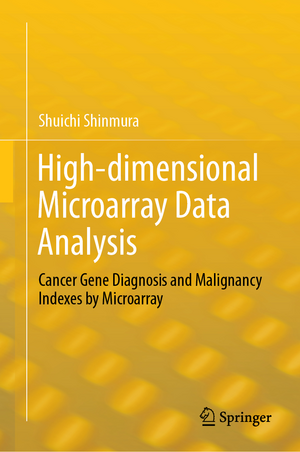High-dimensional Microarray Data Analysis: Cancer Gene Diagnosis and Malignancy Indexes by Microarray
Autor Shuichi Shinmuraen Limba Engleză Hardback – 24 mai 2019
Many studies point out that it is difficult to separate signal and noise in a high-dimensional gene space. However, the definition of the signal is not clear. Convincing evidence is presented that LSD is a signal. Statistical analysis of the genes contained in the SM cannot provide useful information, but it shows that the discriminant score (DS) discriminated by RIP or H-SVM is easily LSD. For example, the Alon microarray has 2,000 genes which can be divided into 66 SMs. If 66 DSs are used as variables, the result is a 66-dimensional data. These signal data can be analyzed to find malignancy indicators by principal component analysis and cluster analysis.
Preț: 794.39 lei
Preț vechi: 968.76 lei
-18% Nou
Puncte Express: 1192
Preț estimativ în valută:
152.02€ • 158.52$ • 126.35£
152.02€ • 158.52$ • 126.35£
Carte tipărită la comandă
Livrare economică 20 martie-03 aprilie
Preluare comenzi: 021 569.72.76
Specificații
ISBN-13: 9789811359972
ISBN-10: 9811359970
Pagini: 350
Ilustrații: XXV, 419 p. 261 illus., 130 illus. in color.
Dimensiuni: 155 x 235 mm
Greutate: 0.8 kg
Ediția:1st ed. 2019
Editura: Springer Nature Singapore
Colecția Springer
Locul publicării:Singapore, Singapore
ISBN-10: 9811359970
Pagini: 350
Ilustrații: XXV, 419 p. 261 illus., 130 illus. in color.
Dimensiuni: 155 x 235 mm
Greutate: 0.8 kg
Ediția:1st ed. 2019
Editura: Springer Nature Singapore
Colecția Springer
Locul publicării:Singapore, Singapore
Cuprins
1 New Theory of Discriminant Analysis and Cancer Gene Analysis.- 2 Overview of Cancer Gene Diagnosis by RIP and Revised LP-OLDF.- 3 Cancer Gene Diagnosis of Alon Microarray.- 4 Further Examinations of SMs---Defect of Revised LP-OLDF and Correlations of Genes.- 5 Cancer Gene Diagnosis of Golub et al. Microarray.- 6 Cancer Gene Diagnosis of Shipp et al. Microarray.- 7 Cancer Gene Diagnosis of Singh et al. Microarray.- 8 Cancer Gene Diagnosis of Tian et al. Microarray.- 9 Cancer Gene Diagnosis of Chiaretti et al. Microarray.- 10 LINGO Programs of Cancer Gene Analysis.- Index.
Notă biografică
Shuichi Shinmura, Seikei University
Textul de pe ultima copertă
This book shows how to decompose high-dimensional microarrays into small subspaces (Small Matryoshkas, SMs), statistically analyze them, and perform cancer gene diagnosis. The information is useful for genetic experts, anyone who analyzes genetic data, and students to use as practical textbooks.
Discriminant analysis is the best approach for microarray consisting of normal and cancer classes. Microarrays are linearly separable data (LSD, Fact 3). However, because most linear discriminant function (LDF) cannot discriminate LSD theoretically and error rates are high, no one had discovered Fact 3 until now. Hard-margin SVM (H-SVM) and Revised IP-OLDF (RIP) can find Fact3 easily. LSD has the Matryoshka structure and is easily decomposed into many SMs (Fact 4). Because all SMs are small samples and LSD, statistical methods analyze SMs easily. However, useful results cannot be obtained. On the other hand, H-SVM and RIP can discriminate two classes in SM entirely. RatioSV is the ratioof SV distance and discriminant range. The maximum RatioSVs of six microarrays is over 11.67%. This fact shows that SV separates two classes by window width (11.67%). Such easy discrimination has been unresolved since 1970. The reason is revealed by facts presented here, so this book can be read and enjoyed like a mystery novel.
Many studies point out that it is difficult to separate signal and noise in a high-dimensional gene space. However, the definition of the signal is not clear. Convincing evidence is presented that LSD is a signal. Statistical analysis of the genes contained in the SM cannot provide useful information, but it shows that the discriminant score (DS) discriminated by RIP or H-SVM is easily LSD. For example, the Alon microarray has 2,000 genes which can be divided into 66 SMs. If 66 DSs are used as variables, the result is a 66-dimensional data. These signal data can be analyzed to find malignancy indicators by principal component analysis and cluster analysis.
Many studies point out that it is difficult to separate signal and noise in a high-dimensional gene space. However, the definition of the signal is not clear. Convincing evidence is presented that LSD is a signal. Statistical analysis of the genes contained in the SM cannot provide useful information, but it shows that the discriminant score (DS) discriminated by RIP or H-SVM is easily LSD. For example, the Alon microarray has 2,000 genes which can be divided into 66 SMs. If 66 DSs are used as variables, the result is a 66-dimensional data. These signal data can be analyzed to find malignancy indicators by principal component analysis and cluster analysis.
Caracteristici
Shows how a new theory of discriminant analysis was used to solve unresolved cancer gene analysis for the first time Explains how high-dimensional data such as microarrays can be decomposed for genetic cancer diagnosis Describes how cancer gene sets included in small Matryoshkas can be separated into cancer and healthy classes
